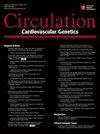Crotti等人对关于文章“长qt综合征的遗传修饰因子:KCNQ1 3'未翻译区变异的作用有多重要?”
Q Medicine
引用次数: 8
摘要
我们很高兴有机会对Amin等人关于3 '非翻译区(3 ' utr)单核苷酸多态性(snp)在1型长qt综合征患者中的修饰作用的文章发表评论。1在Amin等人的原始队列研究中,2对3个小家庭的分析支持了3’utr snp的修饰作用。Amin等人现在提出,单倍体不足型1型长qt综合征致病突变在我国人群中占主导地位可能是导致不同结果的原因。然而,在我们的3个创始家族中,3个突变中的2个(KCNQ1 A341V和KCNQ1 IVS7-2A>G)具有显性负作用,3,4和只有1个(KCNQ1 -G589D)降低了突变蛋白形成功能性四聚体的能力,导致单倍体不足这与他们的3个家庭的模式完全相同:2个家庭有显性的负面影响……本文章由计算机程序翻译,如有差异,请以英文原文为准。
Response by Crotti et al to Letter Regarding Article, "Genetic Modifiers for the Long-QT Syndrome: How Important Is the Role of Variants in the 3' Untranslated Region of KCNQ1?"
We welcome the opportunity to respond to the expected comments by Amin et al regarding our article on the modifying role of 3′ untranslated region (3′UTR) single-nucleotide polymorphisms (SNPs) in type 1 long-QT syndrome patients.1
In the original cohort studied by Amin et al,2 the analysis of 3 small families supported the modifying role of 3′UTR SNPs. Amin et al now propose, as a possible reason for the different results, the predominance of haploinsufficient type 1 long-QT syndrome–causative mutations in our population. However, in our 3 founder families, 2 ( KCNQ1 A341V and also KCNQ1 IVS7-2A>G) of the 3 mutations have a dominant-negative effect,3,4 and only 1 ( KCNQ1 -G589D) reduces the ability of the mutated proteins to form functional tetramers leading to haploinsufficiency.5 This is exactly the same pattern of their 3 families: 2 have a dominant-negative effect …
求助全文
通过发布文献求助,成功后即可免费获取论文全文。
去求助
来源期刊

Circulation-Cardiovascular Genetics
CARDIAC & CARDIOVASCULAR SYSTEMS-GENETICS & HEREDITY
CiteScore
3.95
自引率
0.00%
发文量
0
期刊介绍:
Circulation: Genomic and Precision Medicine considers all types of original research articles, including studies conducted in human subjects, laboratory animals, in vitro, and in silico. Articles may include investigations of: clinical genetics as applied to the diagnosis and management of monogenic or oligogenic cardiovascular disorders; the molecular basis of complex cardiovascular disorders, including genome-wide association studies, exome and genome sequencing-based association studies, coding variant association studies, genetic linkage studies, epigenomics, transcriptomics, proteomics, metabolomics, and metagenomics; integration of electronic health record data or patient-generated data with any of the aforementioned approaches, including phenome-wide association studies, or with environmental or lifestyle factors; pharmacogenomics; regulation of gene expression; gene therapy and therapeutic genomic editing; systems biology approaches to the diagnosis and management of cardiovascular disorders; novel methods to perform any of the aforementioned studies; and novel applications of precision medicine. Above all, we seek studies with relevance to human cardiovascular biology and disease. Manuscripts are examined by the editorial staff and usually evaluated by expert reviewers assigned by the editors. Both clinical and basic articles will also be subject to statistical review, when appropriate. Provisional or final acceptance is based on originality, scientific content, and topical balance of the journal. Decisions are communicated by email, generally within six weeks. The editors will not discuss a decision about a manuscript over the phone. All rebuttals must be submitted in writing to the editorial office.
 求助内容:
求助内容: 应助结果提醒方式:
应助结果提醒方式:


